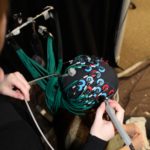Shelby Putt, Indiana University – Functional Brain Networks and Early Stone Tools

To view history, let’s dig into our brains instead of the Earth.
Shelby Putt, postdoctoral research fellow at Indiana University, discusses why learning how our ancestors used their brains can help us understand the evolutionary puzzle.
Dr. Putt is a Postdoctoral Research Fellow at the Stone Age Institute and the Center for Research into the Anthropological Foundations of Technology at Indiana University. She holds a PhD degree in Anthropology from the University of Iowa. Her research utilizes functional neuroimaging technology, the fossil and archaeological records, and experimental methods to investigate the evolution of primate and hominin brains and behaviors through time. She has published articles that explore how cognition, language, tool use and manufacture, social transmission, and learning evolved in our human ancestors. This research has been funded by the Leakey Foundation, Wenner-Gren Foundation, and Sigma Xi, the Scientific Research Society. Prior to coming to the Stone Age Institute, she was an AAUW American Fellow and taught courses in general anthropology, human evolution, and experimental archaeology at the University of Iowa.
Functional Brain Networks and Early Stone Tools
At what point in evolutionary history did our human ancestors start to think more like humans and less like apes?
This is a hard question to answer without a time-machine because — unlike bones — intelligence doesn’t fossilize.
So my team came up with a unique solution. Using a neuroimaging technique called functional near-infrared spectroscopy, we monitored brain activity in modern-day humans as they made the same types of stone tools as early humans. This let us glimpse what parts of the brain are required to make specific stone tools, both in the present and in the past.
Our study’s participants learned how to make simple Oldowan flake and pebble tools and Acheulian handaxes. We chose these because the transition from the Oldowan era to the Acheulian era about 1.8 million years ago is when our brains nearly doubled in size. It’s therefore seen as a turning point in human cognitive evolution.
Our study’s results support this hypothesis.
We discovered that the older form of toolmaking activates brain areas involved in visual inspection and hand movement. It would not be a surprise to find a similar brain network activated in chimpanzees when they crack nuts with stone tools.
But the more recent form of tool-making activates a higher-order cognitive network in the brain involved in higher-level motor planning and managing multi-sensory information with working memory.
Interestingly, this cognitive network is the same one that lights up when a trained pianist plays the piano.

While early humans probably couldn’t play Mozart, our study shows that the same brain network we rely on today to complete complex tasks was likely already evolving 1.8 million years ago.
Read More:
Article published in Nature Human Behaviour: “The functional brain networks that underlie Early Stone Age tool manufacture” by Shelby S. Putt, Sobanawartiny Wijeakumar, Robert G. Franciscus, and John P. Spencer
A summary and review of the published article in Nature Human Behaviour: “Neuroarchaeology: Language and tools in the brain” by Natalie Uomini


